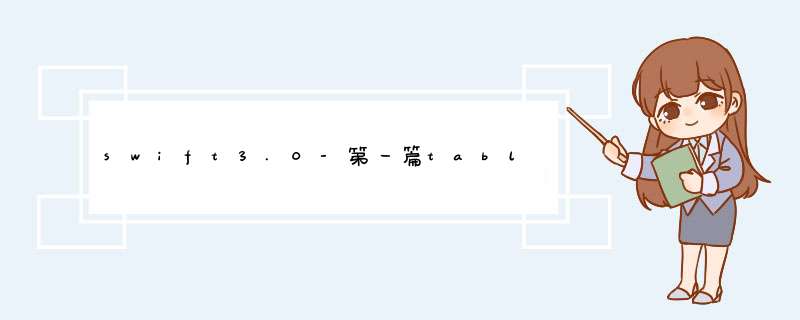
最近这个月估计要一直设计新的项目天天开会苦不堪言啊~ 新的项目要用swift来写,从零开始还是很有乐趣的,简单总结了下table的使用,一起学习下吧。
直接上代码了
<span >//// VIEwController.swift// Swifttable//// Created by a111 on 16/10/19.// copyright © 2016年 司小文. All rights reserved.//// MARK: -import UIKitvar kSize=UIScreen.main.bounds;var datatable:UItableVIEw!var itemStringArr=["企划部","软件部","咨询部","人事部","后勤部","产品部"]class VIEwController: UIVIEwController,UItableVIEwDataSource,UItableVIEwDelegate { overrIDe func vIEwDIDLoad() { super.vIEwDIDLoad() //调用table方法 maketable() // Do any additional setup after loading the vIEw,typically from a nib. } // MARK: -table func maketable (){ datatable=UItableVIEw.init(frame: CGRect(x: 0.0,y: 64,wIDth: kSize.wIDth,height: kSize.height-64),style:.plain) datatable.delegate=self;//实现代理 datatable.dataSource=self;//实现数据源 datatable.showsverticalScrollindicator = false datatable.showsHorizontalScrollindicator = false self.vIEw.addSubvIEw(datatable) //tableFooter datatable.tableFooterVIEw = UIVIEw.init() } // MARK: -table代理 //段数 private func numberOfSectionsIntableVIEw(tableVIEw: UItableVIEw) -> Int { return 1; } //行数 func tableVIEw(_ tableVIEw: UItableVIEw,numberOfRowsInSection section: Int) -> Int { return itemStringArr.count } //行高 private func tableVIEw(tableVIEw: UItableVIEw,heightForRowAtIndexPath indexPath: IndexPath) -> CGfloat{ return 80 } //头部高度 private func tableVIEw(tableVIEw: UItableVIEw,heightForheaderInSection section: Int) -> CGfloat { return 0.01 } //底部高度 private func tableVIEw(tableVIEw: UItableVIEw,heightForFooterInSection section: Int) -> CGfloat { return 0.01 } //cell func tableVIEw(_ tableVIEw: UItableVIEw,cellForRowAt indexPath: IndexPath) -> UItableVIEwCell { let IDentifIEr="IDenttifIEr"; var cell=tableVIEw.dequeueReusableCell(withIDentifIEr: IDentifIEr) if(cell == nil){ cell=UItableVIEwCell(style: UItableVIEwCellStyle.value1,reuseIDentifIEr: IDentifIEr); } cell?.textLabel?.text = itemStringArr[indexPath.row]; cell?.detailTextLabel?.text = "待添加内容"; cell?.detailTextLabel?.Font = UIFont .systemFont(ofSize: CGfloat(13)) cell?.accessoryType=UItableVIEwCellAccessoryType.disclosureIndicator return cell! } //选中cell时触发这个代理 public func tableVIEw(_ tableVIEw: UItableVIEw,dIDSelectRowAt indexPath: IndexPath){ print("indexPath.row = SelectRow第\(indexPath.row)行") } //取消选中cell时,触发这个代理 public func tableVIEw(_ tableVIEw: UItableVIEw,dIDdeselectRowAt indexPath: IndexPath){ print("indexPath.row = deselectRow第\(indexPath.row)行") } //允许编辑cell func tableVIEw(_ tableVIEw: UItableVIEw,canEditRowAt indexPath: IndexPath) -> Bool { return true } //右滑触发删除按钮 func tableVIEw(_ tableVIEw: UItableVIEw,editingStyleForRowAt indexPath: IndexPath) -> UItableVIEwCellEditingStyle { return UItableVIEwCellEditingStyle.init(rawValue: 1)! } //点击删除cell时触发 func tableVIEw(_ tableVIEw: UItableVIEw,commit editingStyle: UItableVIEwCellEditingStyle,forRowAt indexPath: IndexPath) { print("indexPath.row = editingStyle第\(indexPath.row)行") } overrIDe func dIDReceiveMemoryWarning() { super.dIDReceiveMemoryWarning() // dispose of any resources that can be recreated. }}</span>
感谢观看,学以致用更感谢哦~
总结以上是内存溢出为你收集整理的swift3.0-第一篇tableView全部内容,希望文章能够帮你解决swift3.0-第一篇tableView所遇到的程序开发问题。
如果觉得内存溢出网站内容还不错,欢迎将内存溢出网站推荐给程序员好友。
欢迎分享,转载请注明来源:内存溢出

 微信扫一扫
微信扫一扫
 支付宝扫一扫
支付宝扫一扫
评论列表(0条)